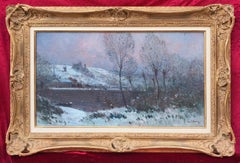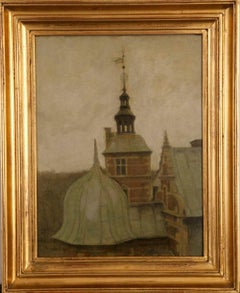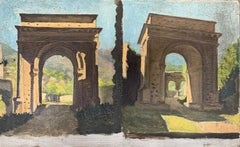Jean Eugene Clary Art
to
1
1
1
1
Overall Height
to
Overall Width
to
1
1
1
6,958
3,331
2,514
1,213
1
1
Artist: Jean Eugene Clary
Winter Landscape by the River
By Jean Eugene Clary
Located in Saint-Ouen, FR
CLARY Jean Eugène (1856-1930)
Winter Landscape by the River
Oil on canvas signed low right
Frame gilded with leaves
Dim canvas : 46 X 80 cm
Dim frame : 68 X 103 cm
CLARY Jean Eugèn...
Category
1880s Academic Jean Eugene Clary Art
Materials
Oil
Related Items
View over the Roof-tops of Frederiksborg Castle, Denmark
By Svend Hammershøi
Located in New York, NY
Svend Hammershoi (1873 Frederiksborg, Copenhagen 1948), View over the Roof-tops of Frederiksborg Castle, Denmark, Oil on Panel, Signed: SH, in it's original frame
"Designer, painter and trained ceramicist, Svend Hammershøi was the younger brother of Vilhelm Hammershøi...
Category
Early 20th Century Academic Jean Eugene Clary Art
Materials
Oil, Panel, Paint
H 13.75 in W 10.38 in D 3 in
Architectural sketch of an Arch in the taste of Palladio
Located in Firenze, IT
Architectural sketch of an arch, executed at two different times of the day.
A classic arch is represented, in the Paladian taste, in the greenery of a park, on a sunny day.
Beautifu...
Category
19th Century Academic Jean Eugene Clary Art
Materials
Oil, Illustration Board
Children on the Beach Marine Landscape French Antique Oil Painting
Located in Norwich, GB
The setting is the French coast, on a tranquil summer's evening. Clouds are drawing in, the sky is turning dusky pink and purple, but there is still time left for play, for the children on the beach...
Category
Early 20th Century Academic Jean Eugene Clary Art
Materials
Oil, Canvas
H 20.48 in W 27.96 in D 1.97 in
"California Sunset"
By Charles Theller Wilson
Located in Southampton, NY
A truly magnificent oil on canvas painting of a sunset off the coast of California in the late 1800's. Signed lower right and in it's original period gold gilt frame which is in excellent condition. Overall it is 33 x 47 inches. Minor stretcher bar wear.
Biography Charles Theller Wilson
Born in San Francisco, CA on Oct. 10, 1855. Wilson first studied painting with his mother, Agnes (California's earliest known woman artist) and later with Jules Tavernier...
Category
1980s Academic Jean Eugene Clary Art
Materials
Oil, Canvas
'A Day in the Country' Dutch Scene, Oil on Linen Painting by Alyona Kostina
By Alyona Kostina
Located in Oklahoma City, OK
This warm, realistic painting depicting a day exploring the Dutch countryside features a golden field with a stream bisecting the landscape with windmills dotting the landscape. The...
Category
2010s Academic Jean Eugene Clary Art
Materials
Linen, Oil
H 27 in W 23 in D 1.5 in
Small Oil Painting From 1902 Called Birch Trees by the Stream
Located in Stockholm, SE
This enchanting painting called Birch Trees by the Stream by Alfred Thörne captures the serene beauty of a small forest scene, measuring just 27 x 17 cm. The artwork is a testament t...
Category
Early 1900s Academic Jean Eugene Clary Art
Materials
Canvas, Oil
H 14.97 in W 11.03 in D 5.12 in
Mythological scene, study for the Prize of Rome 1864, French academism, Homer
Located in Norwich, GB
This rare mythological scene depicting the Greek author Homer on the island of Scyros. You will notice the Trojan War being fought in the background. Our painting, dating from 1864, is unsigned, but has a solid attribution to academic artist Henri-Léopold Lévy...
Category
Mid-19th Century Academic Jean Eugene Clary Art
Materials
Oil, Canvas
H 20.48 in W 23.63 in D 1.58 in
The Young Shepherdess
By Charles Amable Lenoir
Located in New York, NY
The Young Shepherdess by Charles Amable Lenoir (1860-1926)
Oil on canvas
48 x 32 inches unframed (121.92 x 81.28 cm.)
58 ½ x 42 ¾ inches framed (148.59 x 10...
Category
Late 19th Century Academic Jean Eugene Clary Art
Materials
Oil
Fishermen By The Lake, Oil On Canvas, Signed Dommersen, Dutch School, 1870
By Pieter Cornelis Dommersen
Located in Paris, FR
Oil on canvas depicting a scene of Fishermen by a lake, Dutch landscape.
Signed on the lower left corner of Pieter Cornelis Dommersen.
Painter of Dutch seas and landscapes, in Lond...
Category
Late 19th Century Academic Jean Eugene Clary Art
Materials
Oil
H 18.43 in W 23.04 in D 2.37 in
Dance of the Nymphs
By Paul Desire Trouillebert
Located in New Orleans, LA
This lyrical landscape entitled Dance of the Nymphs was composed by the French Barbizon painter Paul Désiré Trouillebert. A joyful scene of nymphs dancing the morning fog, the work closely resembles an important work by the great Camille Corot, which is now housed at the Musée d'Orsay (Paris). Renowned for his unique individuality that toed the line between the traditional and modern, Corot and his landscapes helped pave the way for an entire generation of Impressionists who followed him. Trouillebert perfectly captures the poetic atmosphere of Corot’s groundbreaking works, while also imbuing this scene with a freshness and character that is all his own.
Trouillebert's oil on canvas is exemplary of the tradition of historical painting. The work perfectly combines a realistic depiction of the natural world with a spirited romanticism as his idealized nymph figures frolic playfully beneath a crisp morning sky. As a whole, it is a lovely composition executed with a level of skill and artistry that proves Trouillebert's exceptional talent in the arts.
Born in Paris in 1831, Paul Désiré Trouillebert was a student of the academic painters Ernest Hébert...
Category
19th Century Academic Jean Eugene Clary Art
Materials
Canvas, Oil
La Vieille Ferme - Academic Landscape Oil by Marie-Francois Firmin-Girard
By Marie-Francois Firmin-Girard
Located in Marlow, Buckinghamshire
Signed landscape oil on canvas circa 1890 by French Academic painter Marie-Francois Firmin-Girard. The work depicts a farmyard filled with animals - cows, horses, chickens and ducks.
Signature:
Signed lower left
Dimensions:
Framed: 29"x35"
Unframed: 20"x26"
Provenance:
Private French collection
As a very young man in 1854, Firmin Girard entered the studios of Charles Gleyre...
Category
Late 19th Century Academic Jean Eugene Clary Art
Materials
Canvas, Oil
19th Century female artist Antonietta Brandeism Piazza San Marco, Venice
By Antonietta Brandeis
Located in Petworth, West Sussex
Antonietta Brandeis (Czech / Italian, 1848 – 1926)
Piazza San Marco, Venice
Oil on panel
Inscribed with studio stamp on the reverse
8.1/4 x 4.3/4 in. (21 x 12.1 cm.)
Born in the small Bohemian village of Miskowitz on January 13, 1848, Antonietta Brandeis lost her father at an early age, and probably then moved north to Prague with her widowed mother. At some point in the 1860s, she began studying painting with the Czech artist Karel Javůrek (1815-1909). Although nothing is known about the Brandeis family finances during this period, it would have been unusual for a bourgeois young woman to study painting in any serious fashion; this suggests that perhaps Antonietta’s mother was hoping to provide a marketable skill for her daughter in the world of fine art.
During the 1850s-and 1860s, Prague was the center of the Czech National Revival, a cultural movement whose purpose was the rejuvenation of the Czech language as well as the reclamation of a uniquely Czech identity after centuries under the domination of the Hapsburg Empire. Brandeis’s instructor Javůrek seems to have sympathized with this movement, creating history paintings based on Czech–rather than Hapsburg–moments of significance.
Brandeis studied with Javůrek for a brief period, undoubtedly learning the basics of academic painting. It is likely that he also introduced her to the artistic ideas then current in Belgium and France, having studied himself with Gustave Wappers at the Royal Academy of Fine Arts in Antwerp and with Thomas Couture at the Ecole des Beaux-Arts in Paris. This exposure to European Romanticism and Realism would have offered the young Brandeis a sophisticated understanding of contemporary aesthetic issues.
In the late 1860s, Brandeis left Prague and moved to Venice with her mother, who had married a Venetian gentleman. Once there, she enrolled in the Accademia di belle arti (Academy of Fine Arts) studying with Michelangelo Grigoletti, Domenico Bresolin, Napoleone Nani, and Pompeo Marino Molmenti, all of whom were mainstream academic painters. She graduated in 1872 with a number of honors to her credit, and a Premio award in landscape painting. According to the listing in the Atti della reale Accademia di belle arti in Venezia dell’anno 1872, Brandeis was one of only two women graduating that year, the other being Carolina Higgins, an English woman. The admission of women to officially sponsored fine arts academies in Europe and the US was rare in the 1870s, and enrollment in life classes where nude models posed was almost universally unacceptable for female students. The fact that Brandeis and Higgins seem to have been the only women at the Accademia in the early 1870s tends to suggest that they participated in the same classes as their male classmates. In fact, Brandeis is cited for an award in the “study of the nude”.
After graduation, Brandeis began to establish a career as a landscape painter in Venice. In 1873, she showed four paintings at the annual November exposition at the Accademia; these included one portrait, two landscapes, and one vedute of the Grand Canal that was commissioned by an English woman. Although there is no record of who this English woman was, it is tempting to think that she may have been someone Brandeis met through her classmate Carolina Higgins.
Over the next few decades, Brandeis seems to have exhibited regularly at the annual Accademia shows, but her primary focus was increasingly on painting Venetian scenes (vedute) that appealed to the always plentiful crowd of visitors to Venice. She specialized in relatively small scale paintings of landmarks in her adopted city, and gradually became part of a community of expatriate artists who shared this interest. Among her friends were the Peruvian artist Federico de Campo and many of the Spanish artists then living in Venice such as Mariano Fortuny, Martin Rico and Rafael Senet. It should be noted too that by the end of the nineteenth century, Venice had become a regular stop for any painter who was particularly fascinated with color and light. Some, like the Americans Walter Gay and John Singer Sargent, spent months or even years living there, and others simply made regular visits, such as Pierre-August Renoir and Claude Monet. However, nearly all painters who traveled through Europe made at least one journey to see Venice’s unique environment.
More important for painters like Brandeis were the travelers who came as tourists and wanted a souvenir to take home with them. By the late nineteenth century the aristocratic tradition of the Grand Tour had been considerably democratized by the industrial revolution, which had not only created a newly wealthy merchant class, but had provided the railroad as a means of convenient travel across long distances. Venice was no longer the exotic province of the European aristocracy, but a city that lured bourgeois romantics from all over the world. Brandeis’s images of the city were especially popular with Austrian and English visitors.
Brandeis also painted at least three known altarpieces, all for churches in what is today southern Croatia. In the late 1870s when she received the initial commission, the Dalmatian coast of Croatia had trading and cultural ties to Italy dating back to the Roman Empire; however, it was the region surrounding the Republic of Venice that was most influential in the nineteenth century. During this time, the new bishop of Split (Spoleto), Marko Kalogjera, was actively involved in building new churches in Croatia as well as updating the older ones, and it is likely that he was instrumental in hiring Venetian painters for a variety of commissions. In fact, Michelangelo Grigoletto, one of Brandeis’s instructors at the Accademia, had earlier received a commission for a painting in a parish church in the town of Vodice. Given the remote location, it is not surprising that Bishop Kalogjera would turn to Venice when hiring artists for major projects in the towns of Blato and Smokvici.
The religious traditions of Venetian painting are clearly evident in Brandeis’s Madonna and Child with St. Vitus at the Church of St. Vitus in Blato. The composition is based on the tradition of the sacra conversazione (sacred conversation) between the Virgin Mary and the saints. In this image, Brandeis presents not only St. Vitus, but also a young man who is apparently suffering from one of the illnesses that the saint was known to cure. The large canvas is surrounded by architectural elements above the altar and creates a dramatic statement as worshippers look up at the elegant Madonna.
Brandeis also created two paintings for the church of Our Lady of Carmel in the neighboring town of Smokvici. One features another sacra conversazione, this time with St. Lucia, St. Anthony of Padua and St. Roch. The other is an altarpiece showing the Presentation of Christ in the Temple. These three large scale paintings must have been started in 1879 or 1880 and probably finished several years later.
Concurrent with the major altarpiece commissions, Brandeis continued to produce many vedute for travelers in Venice. She also made a number of trips to Florence, Bologna and Rome where she painted cityscapes of the architectural and urban scenes featuring classical and renaissance motifs. The popularity of her work was further enhanced by the production of chromolithographs of her paintings, probably beginning in the late 1880s or 1890s. She expanded her market even further in 1880 when she exhibited three paintings at the International Exposition in Melbourne. In her personal life, Antonietta married Antonio Zamboni on October 27, 1897; Zamboni was a knight of the Order of Saints Maurizio and Lazzaro, originally founded by the Duke of Savoy in 1572, but closely affiliated with the newly united Kingdom of Italy in the late nineteenth century.
Brandeis’s enthusiasm for Venice seems to have waned somewhat by 1900 when she was quoted as saying that she was still “a foreigner” in Venice, and she no longer participated in any Italian exhibitions, but sent all of her paintings to London. [v] Brandeis’s early association with English collectors seems to have evolved into a relationship that served her well for many decades. Nonetheless, she remained in Venice until the death of her husband in 1909, at which time she moved to Florence.
The full story of Antonietta Brandeis’s life remains unknown, but she seems to have been a woman who challenged social conventions on many levels: as a woman studying in an almost exclusively male academy...
Category
19th Century Academic Jean Eugene Clary Art
Materials
Panel, Oil
H 8.25 in W 4.75 in D 1 in
Jean Eugene Clary art for sale on 1stDibs.
Find a wide variety of authentic Jean Eugene Clary art available for sale on 1stDibs. You can also browse by medium to find art by Jean Eugene Clary in oil paint, paint and more. Not every interior allows for large Jean Eugene Clary art, so small editions measuring 41 inches across are available. Customers who are interested in this artist might also find the work of Emile Godchaux, Charles Joshua Chaplin, and Edmund Darch Lewis. Jean Eugene Clary art prices can differ depending upon medium, time period and other attributes. On 1stDibs, the price for these items starts at $8,626 and tops out at $8,626, while the average work can sell for $8,626.


